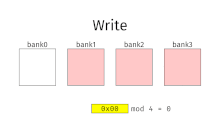Interleaved memory
This article includes a list of general references, but it lacks sufficient corresponding inline citations. (October 2012) |
In
It is different from
Overview
With interleaved memory, memory addresses are allocated to each memory bank in turn. For example, in an interleaved system with two memory banks (assuming

Interleaved memory results in contiguous reads (which are common both in multimedia and execution of programs) and contiguous writes (which are used frequently when filling storage or communication buffers) actually using each memory bank in turn, instead of using the same one repeatedly. This results in significantly higher memory throughput as each bank has a minimum waiting time between reads and writes.
Interleaved DRAM
Main memory (
Data in DRAM is stored in units of pages. Each DRAM bank has a row buffer that serves as a cache for accessing any page in the bank. Before a page in the DRAM bank is read, it is first loaded into the row-buffer. If the page is immediately read from the row-buffer (or a row-buffer hit), it has the shortest memory access latency in one memory cycle. If it is a row buffer miss, which is also called a row-buffer conflict, it is slower because the new page has to be loaded into the row-buffer before it is read. Row-buffer misses happen as access requests on different memory pages in the same bank are serviced. A row-buffer conflict incurs a substantial delay for a memory access. In contrast, memory accesses to different banks can proceed in parallel with a high throughput.
The issue of row-buffer conflicts has been well studied with an effective solution.
In traditional (flat) layouts, memory banks can be allocated a contiguous block of memory addresses, which is very simple for the memory controller and gives equal performance in completely random access scenarios, when compared to performance levels achieved through interleaving. However, in reality memory reads are rarely random due to
The way memory is addressed has no effect on the access time for memory locations which are already cached, having an impact only on memory locations which need to be retrieved from DRAM.
History
Early research into interleaved memory was performed at IBM in the 60s and 70s in relation to the IBM 7030 Stretch computer,[4] but development went on for decades improving design, flexibility and performance to produce modern implementations.
See also
References
- ^ a b c Zhao Zhang, Zhichun Zhu, and Xiaodong Zhang (2000). A Permutation-based Page Interleaving Scheme to Reduce Row-buffer Conflicts and Exploit Data Locality. MICRO' 33.
{{cite conference}}: CS1 maint: multiple names: authors list (link) - ^ "Sun letter to the Director of the Technology Transfer Office of the College of William and Mary" (PDF). July 15, 2005.
- ^ "Professor Xiaodong Zhang Receives 2020 ACM Microarchitecture Test of Time Award". Department of Computer Science and Engineering, College of Engineering, Ohio State University. January 19, 2021.
- ^ Mark Smotherman (July 2010). "IBM Stretch (7030) — Aggressive Uniprocessor Parallelism". clemson.edu. Retrieved 2013-12-07.
